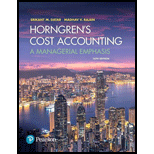
Horngren's Cost Accounting: A Managerial Emphasis (16th Edition)
16th Edition
ISBN: 9780134475585
Author: Srikant M. Datar, Madhav V. Rajan
Publisher: PEARSON
expand_more
expand_more
format_list_bulleted
Concept explainers
Textbook Question
Chapter 6, Problem 6.19MCQ
Responsibility centers. Elmhurst Corporation is considering changes to its responsibility accounting system. Which of the following statements is/are correct for a responsibility accounting system.
- I. In a cost center, managers are responsible for controlling costs but not revenue.
- II. The idea behind responsibility accounting is that a manager should be held responsible for those items that the manager can control to a significant extent.
- III. To be effective, a good responsibility accounting system must help managers to plan and to control.
- IV. Costs that are allocated to a responsibility center are normally controllable by the responsibility center manager.
- 1. I and II only are correct.
- 2. II and III only are correct.
- 3. I, II, and III are correct.
- 4. I, II and IV are correct.
Expert Solution & Answer
Want to see the full answer?
Check out a sample textbook solution
Students have asked these similar questions
Please solve this question general accounting
General accounting
Need help with this general accounting question
Chapter 6 Solutions
Horngren's Cost Accounting: A Managerial Emphasis (16th Edition)
Ch. 6 - What are the four elements of the budgeting cycle?Ch. 6 - Define master budget.Ch. 6 - Strategy, plans, and budgets are unrelated to ore...Ch. 6 - Budgeted performance is a better criterion than...Ch. 6 - Production managers and marketing managers are...Ch. 6 - Budgets meet the cost-benefit test. They force...Ch. 6 - Define rolling budget. Give an example.Ch. 6 - Outline the steps in preparing an operating...Ch. 6 - The sales forecast is the cornerstone for...Ch. 6 - Prob. 6.10Q
Ch. 6 - Define Kaizen budgeting.Ch. 6 - Prob. 6.12QCh. 6 - Explain how the choice of the type of...Ch. 6 - What are some additional considerations that arise...Ch. 6 - Prob. 6.15QCh. 6 - Master budget. Which of the following statements...Ch. 6 - Operating and financial budgets. Which of the...Ch. 6 - Production budget. Superior Industries sales...Ch. 6 - Responsibility centers. Elmhurst Corporation is...Ch. 6 - Cash budget. Mary Jacobs, the controller of the...Ch. 6 - Sales budget, service setting. In 2017 Hart Sons,...Ch. 6 - Sales and production budget. The Coby Company...Ch. 6 - Direct material budget. Dawson Co. produces wine....Ch. 6 - Material purchases budget. The McGrath Company has...Ch. 6 - Revenues, production, and purchases budgets. The...Ch. 6 - Revenues and production budget. Saphire, Inc.,...Ch. 6 - Budgeting; direct material usage, manufacturing...Ch. 6 - Budgeting, service company. Ever Clean Company...Ch. 6 - Budgets for production and direct manufacturing...Ch. 6 - Activity-based budgeting. The Jerico store of...Ch. 6 - Kaizen approach to activity-based budgeting...Ch. 6 - Responsibility and controllability. Consider each...Ch. 6 - Responsibility, controllability, and stretch...Ch. 6 - Cash flow analysis, sensitivity analysis....Ch. 6 - Budget schedules for a manufacturer. Hale...Ch. 6 - Budgeted costs, Kaizen improvements environmental...Ch. 6 - Revenue and production budgets. (CPA, adapted) The...Ch. 6 - Budgeted income statement. (CMA, adapted) Smart...Ch. 6 - Prob. 6.39PCh. 6 - Comprehensive problem with ABC costing. Animal...Ch. 6 - Cash budget (continuation of 6-40). Refer to the...Ch. 6 - Comprehensive operating budget. Skulas, Inc.,...Ch. 6 - Cash budgeting, budgeted balance sheet....Ch. 6 - Comprehensive problem; ABC manufacturing, two...Ch. 6 - Cash budget. (Continuation of 6-44) (Appendix)...Ch. 6 - Budgeting and ethics. Jayzee Company manufactures...Ch. 6 - Kaizen budgeting for carbon emissions. Apex...Ch. 6 - Comprehensive budgeting problem; activity-based...
Knowledge Booster
Learn more about
Need a deep-dive on the concept behind this application? Look no further. Learn more about this topic, accounting and related others by exploring similar questions and additional content below.Similar questions
arrow_back_ios
SEE MORE QUESTIONS
arrow_forward_ios
Recommended textbooks for you
- Principles of Accounting Volume 2AccountingISBN:9781947172609Author:OpenStaxPublisher:OpenStax College
 Managerial Accounting: The Cornerstone of Busines...AccountingISBN:9781337115773Author:Maryanne M. Mowen, Don R. Hansen, Dan L. HeitgerPublisher:Cengage Learning
Managerial Accounting: The Cornerstone of Busines...AccountingISBN:9781337115773Author:Maryanne M. Mowen, Don R. Hansen, Dan L. HeitgerPublisher:Cengage Learning Cornerstones of Cost Management (Cornerstones Ser...AccountingISBN:9781305970663Author:Don R. Hansen, Maryanne M. MowenPublisher:Cengage Learning
Cornerstones of Cost Management (Cornerstones Ser...AccountingISBN:9781305970663Author:Don R. Hansen, Maryanne M. MowenPublisher:Cengage Learning  Managerial AccountingAccountingISBN:9781337912020Author:Carl Warren, Ph.d. Cma William B. TaylerPublisher:South-Western College Pub
Managerial AccountingAccountingISBN:9781337912020Author:Carl Warren, Ph.d. Cma William B. TaylerPublisher:South-Western College Pub Financial And Managerial AccountingAccountingISBN:9781337902663Author:WARREN, Carl S.Publisher:Cengage Learning,
Financial And Managerial AccountingAccountingISBN:9781337902663Author:WARREN, Carl S.Publisher:Cengage Learning, Survey of Accounting (Accounting I)AccountingISBN:9781305961883Author:Carl WarrenPublisher:Cengage Learning
Survey of Accounting (Accounting I)AccountingISBN:9781305961883Author:Carl WarrenPublisher:Cengage Learning

Principles of Accounting Volume 2
Accounting
ISBN:9781947172609
Author:OpenStax
Publisher:OpenStax College

Managerial Accounting: The Cornerstone of Busines...
Accounting
ISBN:9781337115773
Author:Maryanne M. Mowen, Don R. Hansen, Dan L. Heitger
Publisher:Cengage Learning

Cornerstones of Cost Management (Cornerstones Ser...
Accounting
ISBN:9781305970663
Author:Don R. Hansen, Maryanne M. Mowen
Publisher:Cengage Learning

Managerial Accounting
Accounting
ISBN:9781337912020
Author:Carl Warren, Ph.d. Cma William B. Tayler
Publisher:South-Western College Pub

Financial And Managerial Accounting
Accounting
ISBN:9781337902663
Author:WARREN, Carl S.
Publisher:Cengage Learning,

Survey of Accounting (Accounting I)
Accounting
ISBN:9781305961883
Author:Carl Warren
Publisher:Cengage Learning
What is variance analysis?; Author: Corporate finance institute;https://www.youtube.com/watch?v=SMTa1lZu7Qw;License: Standard YouTube License, CC-BY